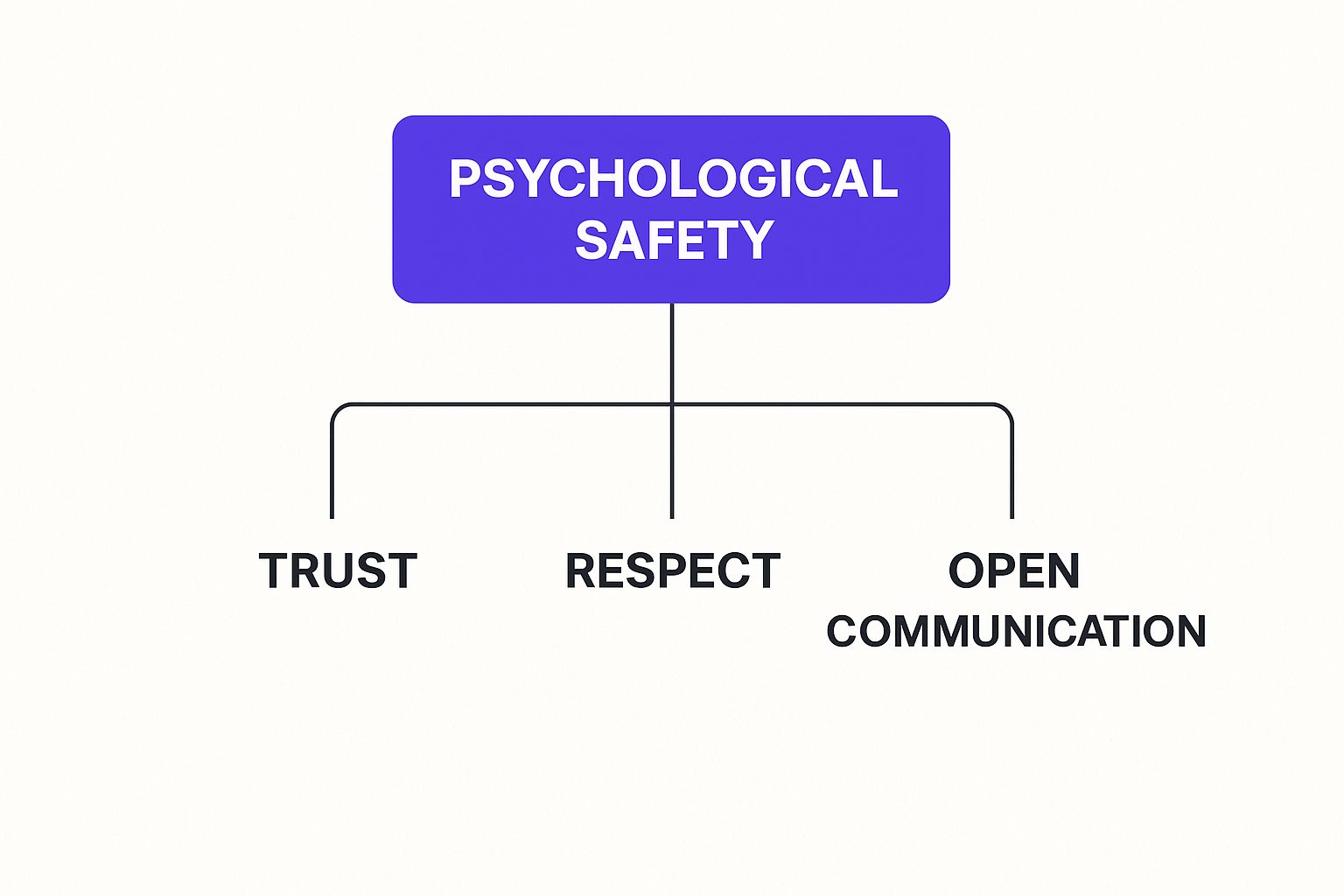Have you ever held back a question in a meeting, worried it would make you look silly? That little knot of fear in your stomach? That's the exact opposite of psychological safety.
In simple terms, psychological safety at work is the shared belief that you won't be punished or humiliated for speaking up. It's feeling secure enough to be vulnerable with your team.
What Does Psychological Safety Actually Mean?

Let's be clear: psychological safety isn't about avoiding tough conversations or being artificially nice. It's about building a high-trust culture where the natural risks of working together—like admitting mistakes or asking for help—don't feel so risky.
Think of it like a trapeze artist working with a net. The artist is free to attempt daring, complex tricks because they trust the net will catch them if they fall. They can push their limits and achieve incredible feats. In the workplace, psychological safety is that net.
It’s the freedom for employees to:
- Say, "I don't know the answer to that."
- Ask for more context on a new project.
- Float a creative, maybe even a little wild, idea.
- Respectfully challenge a manager's opinion.
When that safety net is in place, people stop filtering their thoughts out of fear. This is where real innovation happens. Vulnerability stops being a weakness and becomes a team's secret weapon for growth.
The concept was first introduced by Harvard Business School professor Amy Edmondson, who described it as a team climate where people feel safe enough to take interpersonal risks. Later, Google's massive Project Aristotle study found it was the #1 predictor of successful teams.
Ultimately, you can't have true collaboration or effective problem-solving without it. Open dialogue and honest feedback are the lifeblood of any great team, and building strong conflict resolution techniques makes that foundation even more solid.
Four Signs of a Psychologically Safe Team
So, what does this actually look like day-to-day? You can spot a psychologically safe team by looking for a few key behaviors. These indicators show that trust and respect are genuinely part of the culture.
| Indicator | What It Looks Like in Practice |
|---|---|
| Open Communication | Team members ask questions freely, challenge ideas (even a manager's), and share opinions without fear of being shut down. |
| Willingness to Take Risks | People aren't afraid to propose new, unconventional ideas. Failure is treated as a learning opportunity, not a reason for blame. |
| Mistakes Are Shared | When someone makes a mistake, they own up to it. The team's reaction is to figure out what went wrong and how to fix it, not to point fingers. |
| Mutual Respect | Team members listen to each other and value diverse perspectives. There's a genuine belief that everyone's contribution matters. |
When you see these signs, you're looking at a team that isn't just surviving—it's set up to thrive. This is the kind of environment where people do their best work.
Why Safety Is a Business Imperative, Not Just a Perk

It’s tempting to dismiss psychological safety as a "soft" benefit—a nice-to-have cultural element. But the truth is, it’s one of the most powerful drivers of business performance. A lack of safety isn't just about hurt feelings; it's about missed opportunities, stalled projects, and a bleeding bottom line.
When employees are stuck in a state of fear, their natural instinct is self-preservation. They stop asking questions that might make them look silly. They hesitate to report small mistakes, which quietly snowball into expensive crises. This culture of silence is costly, leading to sluggish problem-solving and a workforce that's always reacting instead of innovating.
The real cost of fear is the innovation that never happens and the talent that quietly walks out the door.
This isn't just a theory. The data draws a straight line between safety and employee engagement. In fact, a healthy culture, which has psychological safety at its core, starts to take shape long before someone is even hired. Companies that focus on how to improve candidate experience not only attract top-tier talent but also build a powerful employer brand that shows they're committed to a respectful and safe environment.
The Financial Impact of Fear vs. Trust
Workplaces low in psychological safety don't just feel bad—they actively disengage their people, causing measurable drops in productivity and motivation. Research from the American Psychological Association's Work in America Survey highlights this perfectly: employees in low-safety environments are twice as likely to feel emotionally exhausted and unmotivated.
On the flip side, teams that feel genuinely safe are more resilient and agile. They innovate more freely because failure isn't a career-ending event. When people feel secure enough to share their best ideas without fear, you can unlock their full potential with things like creative thinking exercises for teams.
Ultimately, putting resources into psychological safety isn’t an expense. It's a direct investment in your company’s productivity, innovation, and ability to keep its most valuable people.
The Four Stages of a Psychologically Safe Workplace
You can't just flip a switch and have a psychologically safe workplace. It’s something that's built carefully over time, layer by layer. Think of it less like an overnight transformation and more like a team climbing a mountain together, reaching new levels of trust and collaboration at each stage.
Seeing psychological safety as a journey through four distinct stages helps you pinpoint exactly where your team is right now. It gives you a roadmap, showing you not just the destination but the very next step to take.
Stage 1: Inclusion Safety
Everything starts with Inclusion Safety. This is the most basic human need we all have: to be accepted for who we are. When your team has inclusion safety, people feel they can show up as their authentic selves—quirks and all—without worrying they’ll be judged, embarrassed, or left out.
It’s the difference between being invited to a party and actually feeling welcome at the party. When people feel they truly belong, they stop wasting energy trying to fit a certain mold. This foundational sense of acceptance is the bedrock upon which all other stages are built.
The image below breaks down how core elements like trust, respect, and open communication come together to build this safe environment.

As you can see, these aren't just separate buzzwords; they're interconnected pillars holding up the entire structure of a healthy team.
Stage 2: Learner Safety
Once people feel they belong, they can relax enough to learn. This brings us to Learner Safety, which is all about feeling secure enough to ask questions, experiment, give and receive feedback, and even say, "I'm not sure, can you explain that?"
In a space with high learner safety, questions are encouraged because they show someone is engaged, not that they're incompetent. Mistakes aren't seen as failures but as valuable learning opportunities. This stage is absolutely critical for growing skills and adapting to change.
Without learner safety, employees will stay silent rather than risk looking uninformed, and innovation grinds to a halt. The fear of asking a "dumb question" is a powerful barrier to progress.
Stage 3: Contributor Safety
After establishing a foundation of inclusion and learning, your team can reach Contributor Safety. This is when people feel safe enough to actually use their talents to make a real difference. It’s the confidence to jump in, apply your skills, and share your work without the fear of being micromanaged or shot down.
This is where you start to see real engagement ignite. Team members feel empowered to use their unique voice and actively contribute to the team’s success. They shift from being passive learners to active participants who shape outcomes.
Stage 4: Challenger Safety
The final, most advanced stage is Challenger Safety. This is the ultimate level of trust, where people feel safe enough to challenge the way things are done. It means speaking up to question an idea, pointing out a potential risk, or suggesting a better approach—even if it goes against the consensus or what a leader has said.
Challenger safety is what separates a good team from a truly great one. It’s the engine of innovation. When people feel safe to push back respectfully, you guard against groupthink and unlock a powerful culture of continuous improvement.
Recognizing Hidden Threats to Team Safety
Psychological safety is a fragile thing. It’s rarely shattered by one big, dramatic event. Instead, it slowly crumbles under the weight of small, everyday actions that often fly completely under the radar. Learning to spot these hidden threats is the very first step toward building a team culture that’s truly resilient.
These threats often show up in the most common workplace situations. Picture a team meeting where someone asks a thoughtful question, only to be met with dead silence. That person immediately feels small, maybe even foolish. Or think about a project review that devolves into a hunt for who to blame, rather than a real chance to learn from mistakes. These moments, big and small, send a powerful message: it’s not safe to be vulnerable here.
A global study by Workplace Options really highlights this. It found that a lack of recognition, a non-existent work-life balance, and friction with managers were huge culprits in undermining psychological safety. In some places, over 40% of employees pointed to tension with their manager as a major source of stress. This draws a straight line between leadership behavior and how safe an employee feels. You can dig into more of the findings on how global work anxieties impact safety.
Common Destructive Patterns to Watch For
Here’s the tricky part: the most damaging behaviors are often unintentional. A manager who only ever celebrates good news, for example, is quietly telling their team that bad news isn't welcome. This creates a culture of hiding problems until they blow up into full-blown crises. In the same way, when new ideas are always shot down with "we tried that already" or "that'll never work," people just stop bringing them up.
Keep an eye out for these specific patterns that can poison a team’s sense of safety:
- Interrupting or Talking Over Others: This sends a clear signal that one person's voice matters more than everyone else's.
- Using Sarcasm as Feedback: Masking criticism with a "joke" just creates confusion and shuts down real, honest conversation.
- Rewarding Silence: When the same two or three people dominate every single discussion, it teaches the rest of the team to just stay quiet.
- Public Criticism: Calling someone out in front of the group, even for a small error, creates a ripple effect of fear for the whole team.
Creating a space where people feel safe enough to speak up, even when it’s tough, is absolutely essential. For instance, giving employees a way to ask anonymous questions can help bring hidden issues to the surface before they fester. It gives leaders the kind of unfiltered feedback they might never get otherwise. Learning to spot these silent threats is the only way to root them out for good.
Practical Ways to Build Psychological Safety on Your Team

It’s one thing to understand what psychological safety is, but it’s another to actually build it. The good news? You don’t need a huge budget or a complicated initiative to get started. It all comes down to simple, consistent habits that you and your team can start practicing tomorrow.
The whole process kicks off when leaders model the behavior they want to see. When a manager openly admits, “I messed that up,” or says, “I don’t know the answer, let’s find it together,” it sends a powerful signal to everyone else.
This simple act of humility reframes vulnerability. It’s no longer a weakness to avoid at all costs, but a normal and even necessary part of getting great work done. It gives others permission to be imperfect, ask for help, and treat failures as learning opportunities instead of reasons to point fingers.
Lead With Curiosity and Openness
A huge part of fostering psychological safety is how you react when people disagree with you. Instead of viewing a different opinion as a threat, actively encourage it. In your next meeting, make a point to ask the quieter folks for their thoughts or even invite someone to play devil's advocate.
Here are a few practical ways to encourage open dialogue:
- Frame challenges as learning moments. Instead of, "We have a problem," try something like, "Here’s a great chance for us to learn something new."
- Acknowledge every idea. Even if a suggestion won’t work, start your response with, "Thanks for sharing that perspective. Let's dig into it a bit."
- Make it okay not to know. Create a culture where "I'm not sure" is a perfectly fine answer that opens the door for the team to solve things together.
A truly safe environment requires a shift from a culture of knowing to a culture of learning. It means leaders have to be intentionally curious, asking more questions and giving fewer top-down answers.
This approach builds a foundation of trust where everyone feels their voice matters. If you want to take it a step further, you can try some structured team trust exercises that build psychological safety to help strengthen those bonds.
Run More Inclusive Meetings
Meetings are where psychological safety is often won or lost. To make them truly inclusive, leaders need to be active facilitators, not just participants. You have to make sure the conversation isn’t dominated by the same two or three people every time.
Set clear ground rules right from the start, like “one person speaks at a time” and “no bad ideas in a brainstorm.” This is especially critical for remote and hybrid teams where it's all too easy for people to fade into the background.
To keep everyone involved, it helps to explore different virtual team engagement ideas designed to make sure everyone feels seen and heard, no matter where they’re logging in from. At the end of the day, a safer team is a more connected and productive one.
Answering Your Key Questions
https://www.youtube.com/embed/UZpc-jOKF-Q
As psychological safety becomes a bigger part of the conversation at work, it’s natural for questions and a few myths to bubble up. Let's tackle some of the most common ones head-on so you can move forward with a clear understanding.
Getting these practical concerns sorted out is key to putting theory into practice.
Is Psychological Safety Just About Being Nice and Lowering Standards?
This is probably the biggest myth out there, and the answer is a hard no. Psychological safety isn't about tiptoeing around tough conversations or letting poor performance slide. In reality, it’s the exact opposite.
It’s about creating an environment where high standards and honest feedback can truly thrive. When people feel psychologically safe, they're willing to engage in healthy debate, question the status quo, and hold each other accountable—all without the fear of being personally attacked or damaging their careers.
Think of it this way: psychological safety is the launchpad for peak performance, not a permission slip for mediocrity. It's what allows a team to be both incredibly ambitious and genuinely supportive.
How Can I Measure Psychological Safety Without a Big Budget?
You don't need a fancy, expensive consultant to get a sense of your team's psychological climate. The first step is to simply start paying closer attention.
- Who speaks up in meetings? Notice who contributes ideas and who tends to stay quiet.
- How does the team respond to a mistake? Is the knee-jerk reaction to assign blame, or does everyone jump in to solve the problem?
- Are people asking questions? A silent room can sometimes signal a fear of looking ignorant, not universal agreement.
If you want something a bit more structured, you can use simple, anonymous pulse surveys. Ask your team to rate straightforward statements like, "I feel comfortable sharing a different opinion with this team." The trick is to do it regularly and, most importantly, show you're acting on the feedback you get.
Does This Work for Remote and Hybrid Teams?
Absolutely, but it takes more conscious effort. When you're working remotely, you miss out on all those small, informal interactions—the quick chat by the coffee machine or the ability to read body language in a meeting. This means leaders have to be much more intentional about building that foundation of trust.
This looks like having consistent and meaningful one-on-one meetings, setting clear expectations for communication on platforms like Slack or Teams, and making a point to ask for input from the quieter folks on video calls. It also becomes even more important to celebrate the learning process, not just the final wins. Building those personal connections is crucial, and you can find great ideas for remote team building that help close the virtual gap and create a real sense of community.
Ready to build a brainstorming process that nurtures psychological safety and drives real results? Bulby provides a guided, structured experience that ensures every voice is heard, turning your team’s creative potential into your next great idea. Start your journey with Bulby today.

